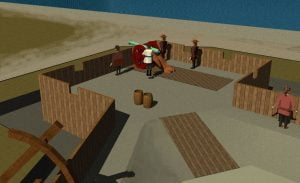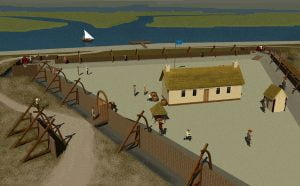René Goulaine de Laudonniére described Charlesfort as a simple, triangular earthen fort, reinforced with vertical timbers and bales of faggots (small limbs.) It contained a fairly large timber-framed warehouse in the center, plus a small house for the commander, a somewhat larger house for the officers and a barracks for the enlisted men. Much of the construction of the buildings was done by local Natives. Presumably, these buildings resembled Native American structures of the region. There was also a cooking shed, an outhouse, a covered oven, well and a woodshed.
Charlesfort would have given little protection from a warship, a sizable European force, or even one of the trained, disciplined armies maintained by Muskogean provinces within the interior of the Lower Southeast. In particular, a night time attack using flaming arrows, would have been catastrophic. It could well be that their store house was set on fire by flaming arrows fired by neighboring Edisto Indians.
South Carolina archaeologists currently believe that they have found the location of Charlesfort on Parris Island, SC, within the U.S. Marine Reservation. The location matches the description of Charlesfort’s landscape, provided by de Laudonniére. French-made artifacts were found in the lower levels of a fort constructed by the Spanish. The Spanish burned the French fort in 1565, but apparently rebuilt it in 1566.
The launch of the first colonial voyage occurred a month before the beginning of the French Wars of Religion. In March of 1562, troops employed by the Duke of Guise massacred an unarmed Huguenot congregation inside their church at Wassy, France. Warfare soon raged across France. Of course, Ribault continued his plans for colonization with the assumption that all was normal back in France.
Jean Ribault and René Goulain de Laudonniére made contact with a powerful Native king, they named Audisto. His name is most likely the same person, named Edisto five years later by the Spanish settlers of Port Royal Sound. Audisto introduced the Frenchmen, who were sub-kings of neighboring provinces. Relations with their neighbors were excellent. Ribault had a trunk filled with trinkets at his side often, so he could always end diplomatic meetings with gifts. The French made no effort to impress the Indians with their superior military
During the early phase of the first expedition, de Laudonniére was given a chunk of silver ore by one of his Native American hosts. The leader said that it came from a mine that was at the base of a very high mountain. This description appears to be the silver deposits in Nantahala Gorge, NC. An old silver mine was discovered there by early settlers. In 1567 the chronicler of Spanish explorer Captain Juan Pardo mentioned that silver ore was found in a location that matches Nantahala Gorge.
The French also observed important Native leaders wearing gold chain necklaces. They were told that the gold came from the mountains to the north. It was mined by the Apalache people, who lived in the mountains. De Laudonniére did not have time to explore the mountainous land of the Apalache, but planned to do so when he returned from France with more colonists.
A small, triangular earthen and timber fort was built by the members of the first expedition. Twenty-eight men, commanded by Captain Albert, volunteered to stay at the fort, while the ships returned to France for supplies and more colonists. This was in late spring, when food was plentiful and the Natives friendly. Relations with their neighbors were initially very friendly since the French did not use the ruthless tactics that were typical of the Spanish. On June 11, 1562 the majority of the Frenchmen under the command of Jean Ribault, sailed for France.
Jean Ribault’s fleet arrived at the coast of France on July 20, 1562. Ribault planned to return immediately to Charlesfort. However, when he approached Le Havre, he found that he could not land because of a raging war between the Catholics and Protestants. After participating in some of the battles, he sailed to England, where he had an audience with Queen Elizabeth I in hope of receiving aid for the French Protestants. After being initially being treated hospitably, he was charged with espionage and briefly held prisoner in the Tower of London.
In the mean time, things were going downhill fast for the garrison at Charlesfort. They were adjacent to a bay teeming with fish and shellfish, but none of the volunteers knew how to fish. In France, fresh water fish, deer and boar were considered the exclusive property of the nobility. All of the professional seawater fishermen had returned to France with Ribault.
A small party of the Frenchmen from Charlesfort went up the Edisto River about 65 miles to join the celebration of the Solar New Year presided over by King Audisto (Edisto in Spanish archives.) The journey had a dual purpose of continuing friendly relations with the indigenous peoples and obtaining food. Both objectives were accomplished successfully. The Frenchmen returned home with enough food to last for several months. However, only a few days afterward, their storehouse caught fire during the night. Almost all their food and equipment were destroyed in the flames.
It has long been assumed that the Native peoples around Port Royal Sound were Muskogeans, because their descendants became members of the Creek Confederacy in the 1700s. However, the indigenous words recorded in the memoirs of de Laudonniére suggest otherwise. Most of the tribal, political or personal names in the Port Royal Sound area are obviously Muskogean words. Instead of using the Muskogean title of mako or mikko, the South Carolina coastal tribes called their king a paracusa. Paracusa is derived from the coastal Peruvian ethnic name, Paracus. The Paracus were the people who built the famous Natzca lines in the desert of Peru. The name of one of the local kings was recorded as being Maccou. This may be the Maya and Itsate Creek word for king, mako. However, his province was described as being the same ethnic group as the others.
The South Carolina coastal people did observe the Green Corn Festival, but very few of the other Muskogean traditions were associated with their festival. Their sun god was named Toya, which is not similar to the Muskogee word for sun, hese, or the Itsate word for sun, hene. However, Toya WAS the sun god of the Calusas. In fact, after the second voyage, the Frenchmen visited a king name Calusa.
The Frenchmen’s situation became desperate over night. After the fire, they had very little food reserves and no longer had much of the equipment required for hunting or fishing. Compounding their dire condition was the lack of trade items to exchange for food. Neighboring towns had no more food reserves. A small party canoed southward along today’s Inter-coastal Waterway, about 25 miles north to the province of a king named Oede, who was a brother of king Edisto. Paracusa Oede gave the Frenchmen enough food for the garrison to survive several more weeks.
Meanwhile, morale at Charlesfort was rapidly degenerating. Captain Albert substituted tyranny for leadership. He hanged a drummer boy, very popular with the garrison, for some trivial offense. Another man was exiled to an uninhabited island without food or weapons. The remaining observed that their captain was becoming increasingly irrational. They feared that one by one, they would die from the noose, starvation or disease. The garrison killed Captain Albert and began building a sea-going boat to carry the survivors back to France. Their newly elected captain, Nicholas Barré, immediately brought dissention to an end.
The French garrison still had the iron tools to build a boat, but no rope or sails. Paracusa’s Oudesta and Oede brought more than enough rope for the boat’s rigging. The sails were sewn from bed linens and excess clothing. The planks of the boat were caulked with Spanish moss and pine tar. They loaded the boat with the cannons and remaining munitions, which left too little space for food. This was a bad mistake. All the remaining supplies, tools and equipment were given to their Indian friends, which made them quite happy with the bargain.
The boat departed in the middle of hurricane season along the South Atlantic Coast. This time of the year on the Carolina coast is characterized by stagnant air punctuated suddenly by violent storms. None of the Frenchmen were experienced sailors or navigators. They did not know to sail east a day or two and pick up the Gulf Stream. Instead they hugged to the coast and traveled only 75 miles in three weeks. The insufficient food they took on board was running out, and they had not brought fishing tackle.
From the beginning of the voyage the ration had been 12 grains of corn a day. When the food was completely gone, the crew quickly began starving. They began eating their leather belts, jackets and shoes. When all the leather was gone, the men gave up hope. Then, a hurricane struck the boat. It was almost filled with water, but in the process, was driven much closer to Europe. One of the crew promised the others that France was only three days away. They bailed out the boat and speeded toward home.
When land did not appear in three days, the men became disheartened again. Many wanted to commit suicide. Finally, their leader suggested that one man should be sacrificed so the others could live. They drew lots to see who would be killed and eaten by their comrades. A man named Lachere drew the unfortunate lot. Meanwhile the boat drifted northeastward.
Just at the point when the Frenchmen were debating whether to kill another one of their comrades or commit mass-suicide, a boat and land was spotted. The small boat happened to contain a Frenchman, who had sailed to New France, along with some Englishmen. They were nursed back to health by their English hosts. The healthiest then had an audience with Queen Elizabeth. She was planning to start an English colony in the New World and also wanted first hand information on the situation in France. Of course, the Frenchmen didn’t even know that a religious war had broken out in France.
Many of the Protestant members of the surviving Charlesfort garrison never returned to France. They feared that they would be burned at the stake for being simultaneously Protestants and cannibals. The King of France did not learn the full details of the failed attempts to establish French colonies in North America until 1565 when Captain René Goulain de Laudonniére submitted his report.


